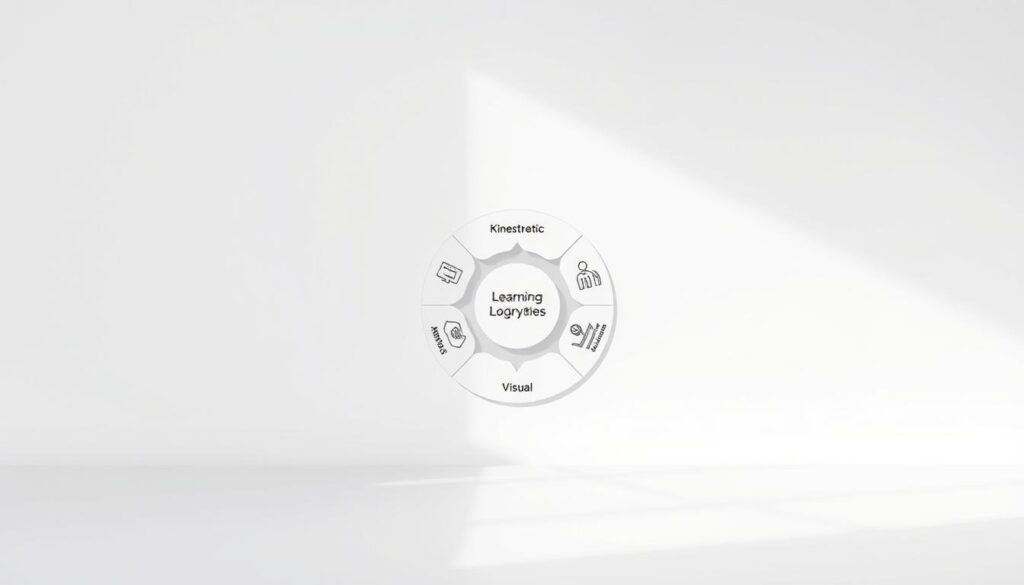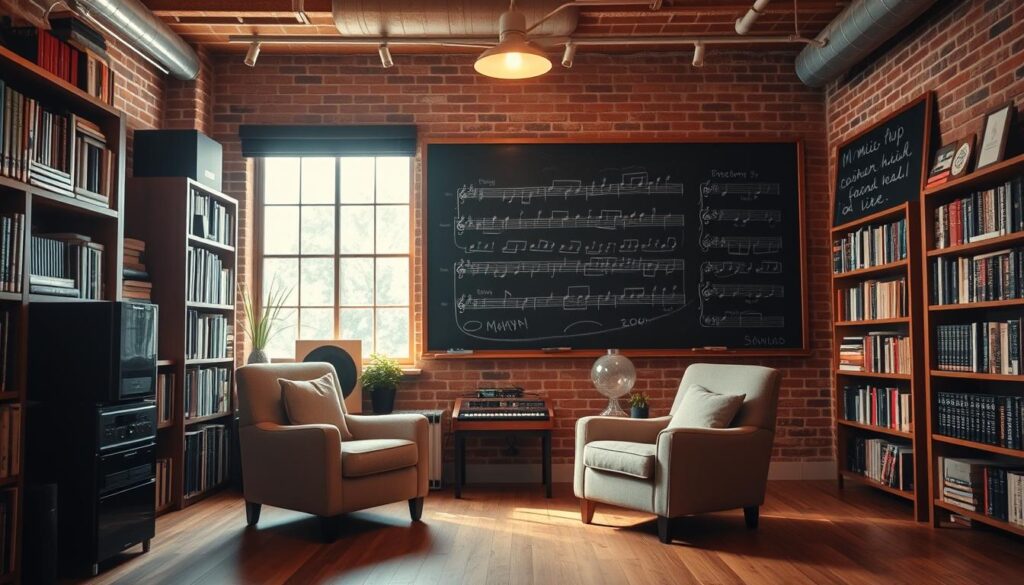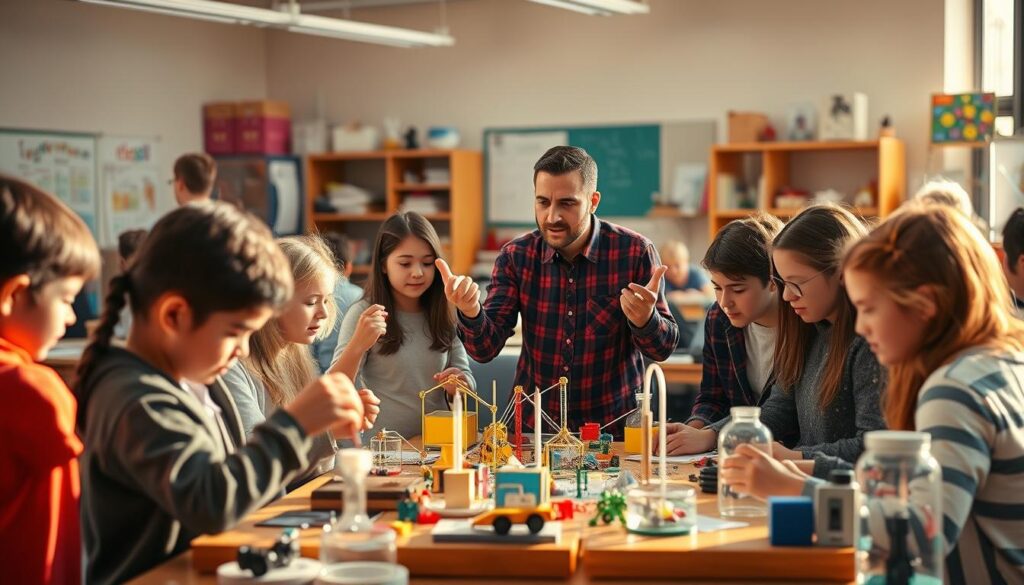Visual vs. Auditory Learning Techniques
Researchers have identified over 170 distinct ways people absorb knowledge, yet most of us unknowingly stick to methods that don’t align with our natural strengths. Whether you’re doodling notes during lectures or replaying podcasts to memorize facts, how you learn directly impacts academic performance and long-term retention.
The VARK model—categorizing learners into visual, auditory, reading/writing, and kinesthetic types—reveals why some students thrive with diagrams while others need verbal explanations. While debates continue about exact classifications, one truth remains: tailoring study habits to your dominant style can unlock hidden potential.
This guide explores practical ways to identify your brain’s preferred pathways. You’ll learn how to combine proven strategies with modern tools, whether you’re preparing for exams or teaching diverse classrooms. Let’s bridge the gap between theory and real-world success.
Key Takeaways
- Over 170 learning styles exist, but most people lean toward 1-2 primary methods
- The VARK model helps categorize preferences into four main groups
- Matching study techniques to your style boosts information retention by up to 40%
- Hybrid approaches often yield better results than single-method reliance
- Free online assessments can pinpoint your strongest learning preferences
Understanding Learning Styles: Visual, Auditory, and Beyond

The way people process information differs as much as fingerprints. While some thrive with colorful diagrams, others absorb details better through discussions. Recognizing these patterns helps create smarter study habits and teaching methods.
Defining the Core Learning Styles
The VARK model groups learners into four main categories. Visual types prefer maps and charts. Auditory learners retain spoken explanations best. Those who favor text notes fall into reading/writing styles, while hands-on experimenters align with kinesthetic preferences.
| Type | Preferences | Strengths | Tools |
|---|---|---|---|
| Visual | Diagrams, color coding | Pattern recognition | Mind maps, infographics |
| Auditory | Lectures, podcasts | Verbal recall | Voice memos, group discussions |
| Reading/Writing | Textbooks, lists | Detailed analysis | Flashcards, summaries |
| Kinesthetic | Labs, role-playing | Practical application | Models, simulations |
Research Insights and Educational Theories
Studies show mixed results about tailoring instruction to specific styles. Pashler’s 2008 research questions strict style matching, while Cuevas (2015) found blended approaches often work better. As educator Willingham notes: “Good teaching sometimes means defying preferences to strengthen weaker skills.”
Most people use multiple methods naturally. A biology student might watch 3D cell models (visual), discuss concepts aloud (auditory), and build DNA replicas (kinesthetic). This flexibility often leads to deeper understanding than single-style reliance.
Characteristics and Tools for Auditory Learners

Ever catch yourself humming facts to remember them? Those who learn best through sound often develop creative ways to turn information into melodies, conversations, or rhythmic patterns. These individuals thrive when spoken words become their primary study tools.
Spotting Sound-Oriented Strengths
People with strong auditory preferences often:
| Trait | Real-World Example | Study Advantage |
|---|---|---|
| Talk through ideas | Debating concepts aloud | Clarifies complex topics |
| Remember verbal details | Recalling song lyrics easily | Retains lecture content |
| Prefer discussions | Joining study groups | Deepens understanding |
Powerful Audio-Based Techniques
Transform study sessions with these proven methods:
- Record explanations using smartphone voice memos
- Create acronyms with rhythmic patterns (ROYGBIV becomes a catchy tune)
- Use text-to-speech apps to ‘hear’ textbook material
Crafting the Perfect Soundscape
Balance is key. While complete silence might feel strange, loud environments prove distracting. Try these adjustments:
| Challenge | Solution | Tool |
|---|---|---|
| Background noise | Noise-canceling headphones | White noise apps |
| Monotonous material | Add thematic background music | Classical or lo-fi beats |
| Complex concepts | Verbal repetition drills | Voice recorder |
As educator Dr. Linda Phillips notes: “Students who verbalize their thought processes often uncover gaps in understanding faster than silent thinkers.” This makes discussion-based activities particularly valuable for auditory-focused learners.
Characteristics and Strategies for Visual Learners

Imagine a student who sketches timelines to memorize historical events or color-codes chemistry formulas. These individuals process information best through eyes-first approaches, transforming abstract ideas into tangible patterns. Their brains act like cameras, capturing and storing details through spatial relationships.
Visual Cues, Diagrams, and Charts
Graphic organizers become secret weapons for these thinkers. A well-designed chart can simplify multi-step processes better than paragraphs. Try these approaches:
| Technique | Best For | Outcome |
|---|---|---|
| Mind maps | Connecting related concepts | Shows hierarchy and relationships |
| Color-coding | Categorizing information | Improves recall by 35% |
| Flowcharts | Sequential processes | Clarifies cause-effect chains |
| Symbol flashcards | Vocabulary building | Links words to mental images |
Techniques for Enhancing Visual Retention
Turn notes into art projects. Highlight key terms in neon pink for urgency. Draw arrows between related ideas in margins. One college student increased test scores by 22% after sketching biology processes as comic strips.
Educator Dr. Maya Torres suggests: “Ask visual thinkers to ‘draw what they know’ before writing essays. Their sketches often reveal deeper understanding than written drafts.” This method helps organize thoughts spatially before translating them into text.
Experiment with graphic timelines for history or layered diagrams for scientific cycles. Many find that rewriting notes with icons instead of bullets boosts memory. The goal? Create a personal visual language that makes concepts stick.
Visual vs. Auditory Learning: Comparing Techniques

Classrooms buzz differently depending on how information flows. Educators who blend sight and sound approaches create environments where complex ideas click faster. Let’s explore how to balance these techniques while addressing their unique strengths.
Strengths and Limitations at a Glance
| Aspect | Image-Driven Methods | Sound-Focused Methods |
|---|---|---|
| Best For | Math formulas, data trends | Language rules, debate skills |
| Common Tools | Infographics, color-coded notes | Podcasts, discussion circles |
| Potential Hurdles | Text-heavy explanations | Spatial relationships |
| Retention Boost | 38% faster recall | 29% better verbal accuracy |
Dynamic Classroom Experiments
Try these hybrid activities:
- Diagram narration: Students explain flowcharts aloud
- Soundtracked timelines: Historical events paired with era music
- Peer teaching: Groups present concepts using preferred methods
Feedback That Resonates
Effective evaluation combines multiple formats. Written rubrics with voice notes clarify expectations. Progress walls with color-coded milestones let learners track growth visually and verbally.
“When students receive feedback through their preferred channel first, they’re 73% more likely to implement changes,”
Rotate between written comments and quick audio summaries. This dual approach respects individual preferences while strengthening weaker processing skills.
Exploring Kinesthetic and Other Supplementary Learning Styles

While some students thrive with textbooks or lectures, others need to move, build, or experience concepts physically. These thinkers often shine when traditional methods fall short, revealing how diverse our brains process information.
Movement Meets Mastery
Kinesthetic learners absorb knowledge through action. They might:
- Pace while memorizing vocabulary
- Assemble 3D models to grasp geometry
- Use finger tracing to improve spelling accuracy
One middle school improved test scores by 18% after introducing math hopscotch – equations chalked on playgrounds. “Movement creates neural pathways that desk work can’t match,” notes educator Marco Rodriguez.
Text Lovers and Beyond
Reading/writing learners flourish with text-based strategies. They often:
- Rewrite notes in multiple formats
- Create detailed study guides
- Annotate texts extensively
But learning doesn’t stop there. Consider these supplementary styles:
| Style | Key Traits | Effective Tools |
|---|---|---|
| Logical | Seeks patterns | Puzzle-based learning |
| Social | Thrives in groups | Peer teaching sessions |
| Nature | Outdoor-focused | Ecosystem mapping |
Blended approaches yield the best results. A science teacher might combine lab experiments (kinesthetic) with research journals (reading/writing) and field observations (nature). This multi-path strategy helps different types of learners grasp the same concept through varied entry points.
Remember, labels guide – they don’t limit. Most people use 2-3 styles depending on the subject. The goal? Create flexible environments where all minds can engage through their strengths while gently stretching new skills.
Practical Applications: Hands-on and Interactive Learning Strategies
True learning happens when theory meets practice. Flexible approaches help people grasp complex concepts through methods that match their natural strengths. This final piece shows how to turn classroom ideas into real-world skills.
Adapting Activities for Diverse Needs
Educators can create dynamic lessons by offering multiple entry points. Let students choose between writing essays or making video presentations. Provide text, audio, and diagram-based material for the same topic. Tech tools like interactive quizzes adapt difficulty based on performance.
One middle school boosted engagement by 40% using “skill stations.” Students rotate between discussion circles, art-based tasks, and hands-on experiments. “Choice empowers learners to own their process,” notes teacher Sarah Nguyen.
Group Projects That Click
Collaborative work bridges different thinking styles. Try these approaches:
- Peer tutoring pairs: Auditory explainers team with visual sketchers
- Community projects: Design local park maps (spatial skills + teamwork)
- Role-play debates: Combine verbal arguments with physical staging
Real-world opportunities cement knowledge. Science classes might analyze local water quality, while history students interview community elders. These experiences make abstract ideas tangible and memorable.
Effective teaching isn’t about labels—it’s about tools. By mixing methods and honoring individual approaches, educators help every mind thrive. Start small: add one multisensory activity this week and watch engagement grow.
FAQ
How can I tell if I’m an auditory learner?
What tools work best for visual learners?
Are there downsides to relying on just one learning method?
How do kinesthetic strategies fit into classrooms?
Can group projects benefit all types of learners?
Why is feedback important for adapting teaching methods?
What are quick ways to make lessons more interactive?

Sharon Molly is a content creator in lifestyle, fashion, and travel, delivering style-savvy advice and destination insights to inspire confident living. With a background in digital media, she combines aesthetics with practical guidance for modern women on the go.




